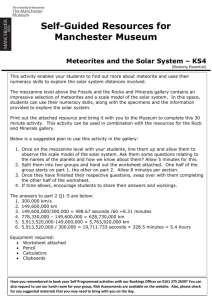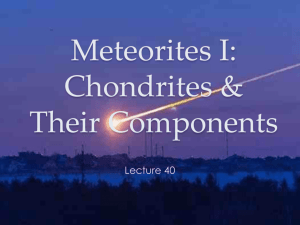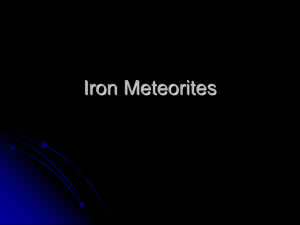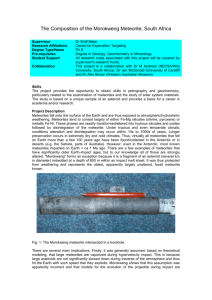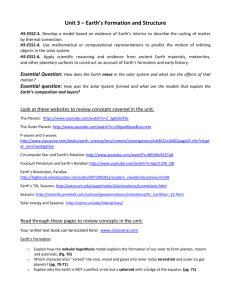Formation of the Solar System
advertisement
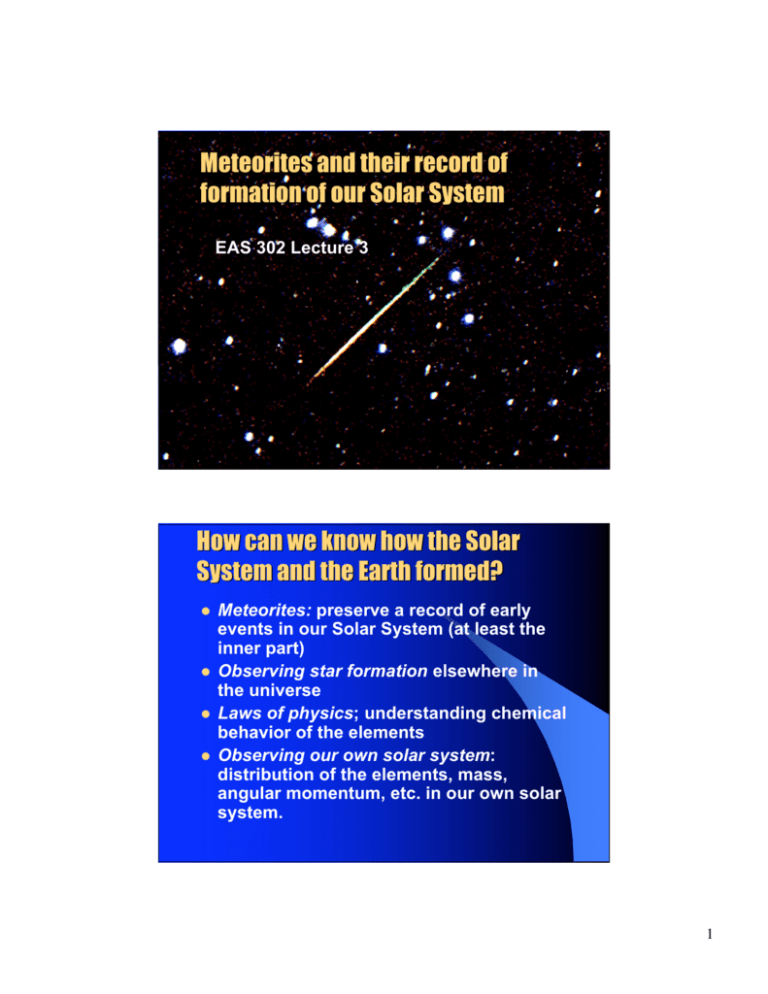
Meteorites and their record of formation of our Solar System EAS 302 Lecture 3 How can we know how the Solar System and the Earth formed? Meteorites: preserve a record of early events in our Solar System (at least the inner part) Observing star formation elsewhere in the universe Laws of physics; understanding chemical behavior of the elements Observing our own solar system: distribution of the elements, mass, angular momentum, etc. in our own solar system. 1 Meteorites Much of the evidence for how the solar system formed comes from meteorites. Meteorites are simply stones that fall from the sky. Most come from asteroids of the asteroid belt (judging from reconstructed orbits). A few from Mars and the Moon. Meteorites Meteorites were once parts of larger bodies: asteroids and planetesimals. Broken up as orbits are perturbed by Jupiter, causing collisions among asteroids 2 Meteorites are usually divided into three classes: Irons iron-nickel alloy Stones mostly silicates (like Earth’s mantle & crust) Stony-Irons Mixture of the above A better classification is: Primitive Meteorites Chondrites These meteorites contain information about the formation of the Solar System Differentiated Meteorites Irons, stony-irons and nonchondrule-bearing stones called achondrites. Achondrites are similar to igneous rocks These meteorites provide information about the formation of planets 3 Some ‘Cosmochemical’ Definitions: Volatile: elements with low boiling points or forming compounds with low boiling points Refractory: Elements with high boiling points or forming compounds (oxides) with high boiling points. Chondrules and Chondrites Chondrites are socalled because they contain chondrules. Chondrules are mmsized spheres that were once molten. Show evidence of rapid cooling. Many different mineralogical kinds, but individuals are mostly monomineralic. 4 Chondrites Classes Carbonaceous (C) compositions close to that of the Sun for non-volatiles Ordinary (H, L, LL) Enstatite (E) (plus several newly discovered classes) Classes related by variation in: metal content volatile element content state of oxidation Chemical variations between classes thought to be due to processes in solar nebula Many chondrites contain decay products of radioactive elements synthesized shortly before they formed. Constituents of Chondrites Chondrules once molten droplets: give evidence of high temperatures for short times Likely formed in shock waves. Refractory Inclusions highly refractory compounds such as Al, Ti, Ca oxides rich in Platinum group metals and refractory trace elements gas condensates or refractory residues give evidence of very high temperatures Matrix More volatile material, metal; rich in C, H (e.g., carbonates, hydrated silicates, and organic molecules (in carbonaceous chondrites) Ameboidal Olivine (condesnate from solar nebula). Includes, in some cases, presolar grains 5 Composition of Carbonaceous Chondrites The most “primitive” of the chondrites are the carbonaceous chondrites, particularly those of class CI. Except for the most gaseous elements, their composition matches that of the Sun. CI meteorites consist only of “matrix”; no chondrules. Considered to be collection of variably processed dust from the solar nebula So why the STARDUST Mission? Differentiated Meteorites Achondrites igneous or brecciated (broken-up) textures similar to igneous rocks from Earth and Moon Irons Appear to have cooled from molten iron textures give evidence of slow cooling: interiors of asteroid size bodies (10 to 1000 km diameter) Chemical variations reflect melting and segregation on parent bodies 6 Meteorite Ages Most meteorites give ages close to 4.556 Ga by most dating methods. (Ga = billion years) Primitive meteorites generally slightly older than differentiated ones, but not by much Virtually all events recorded in meteorites occurred within few 10’s of millions of years of 4.56 Ga. A small group of achondrites gives much younger ages (e.g., 1.3Ga). These are the SNC meteorites, thought to be from Mars; there are also a few rare meteorites from the Moon. Cosmic ray exposure ages much younger: meteorites came from larger bodies. Isotopic “Anomalies” in Meteorites Some parts of some meteorites contain elements whose isotopic composition is different from that of other materials from solar system. Most noteworthy in meteorites of classes CV and CM. Anomalies found in Calcium-Aluminum Inclusions (CAI’s) Chondrules Matrix 7 Kinds of Isotopic Anomalies Decay products of short-lived radioactive nuclides: 26Mg (from 26Al – t1/2 = 0.7 Ma) (from 129I – t1/2 = 16 Ma) 53Cr (from 53Mn – t 1/2 = 3.7 Ma) 129Xe Variation in isotopic composition of many elements, particularly C, N, Si, in minute diamonds, SiC, and graphite of groundmass. Variation of O isotopic composition among all meteorite classes Variation in isotopic composition of all elements in a few rare CAI’s However, most elements in most meteorites have uniform isotopic composition - so the solar nebula was mostly well mixed. Meaning of Isotopic Anomalies? One or more (likely the latter) episodes of heavy element nucleosynthesis shortly before the solar system formed. Red Giant(s) and/or Supernovae Some radiogenic nuclides (particularly 10Be and possibly 26Al) may have been produced by spallation resulting from collisions with energetic atoms accelerated by the magnetic fields of the young Sun. Short-lived radionuclides can be used to deduce the chronology of events in the early Solar System. 8 Summary: what do meteorites tell us? The solar system formed 4.56 billion years ago. Features of the most primitive meteorites (chondrites) are consistent with formation from a cloud of gas and dust. At least locally, the solar nebula was very hot – hot enough to melt some material and vaporize other material. Planetesimals formed and differentiated very quickly (segregation of iron to form cores). Time scales of a few million to a few tens of millions of years. Planetesimals were hot enough to melt extensively. The solar nebula was, for the most part, well mixed. One of more episodes of nucleosynthesis occurred very shortly before the solar system formed - hence there were red giants and supernova explosions in the neighborhood. 9

